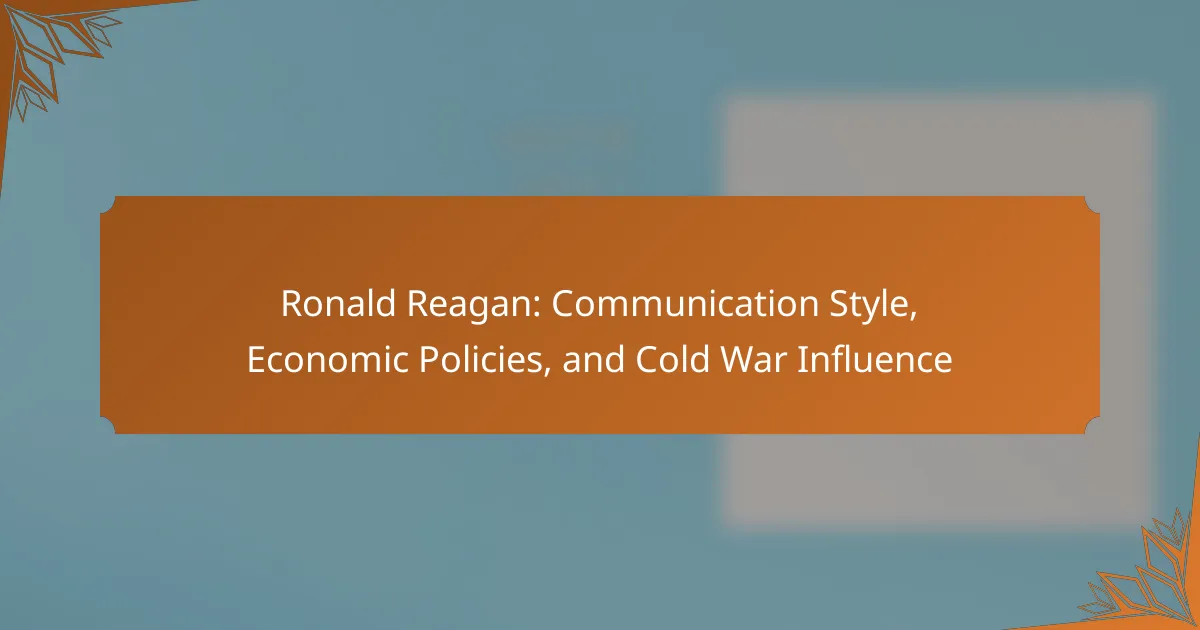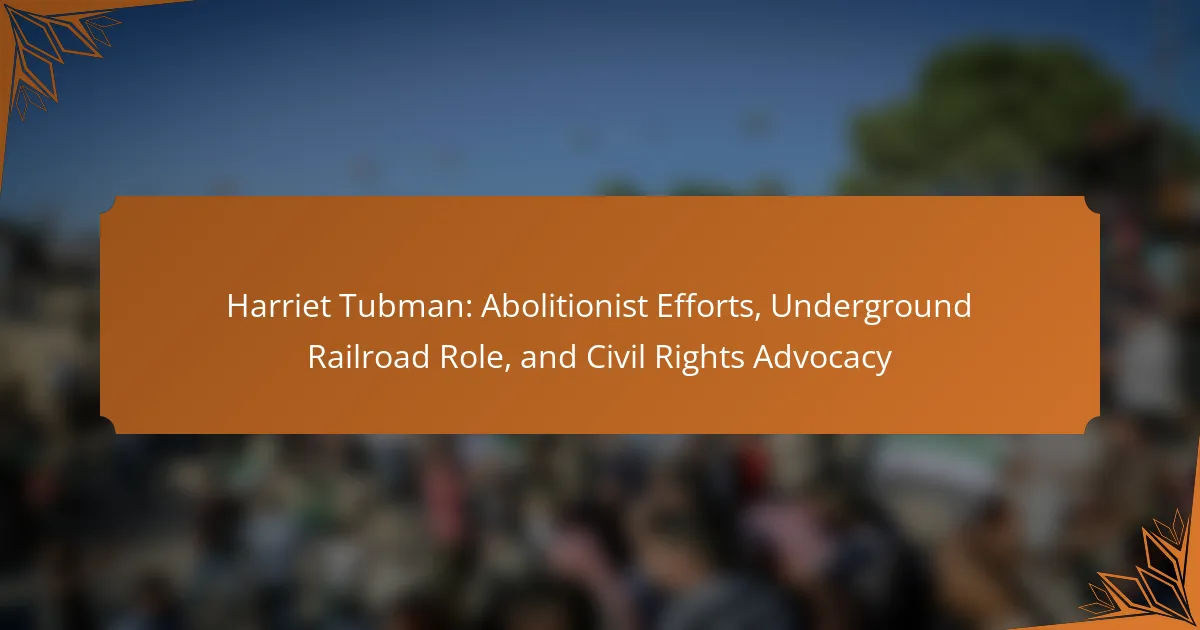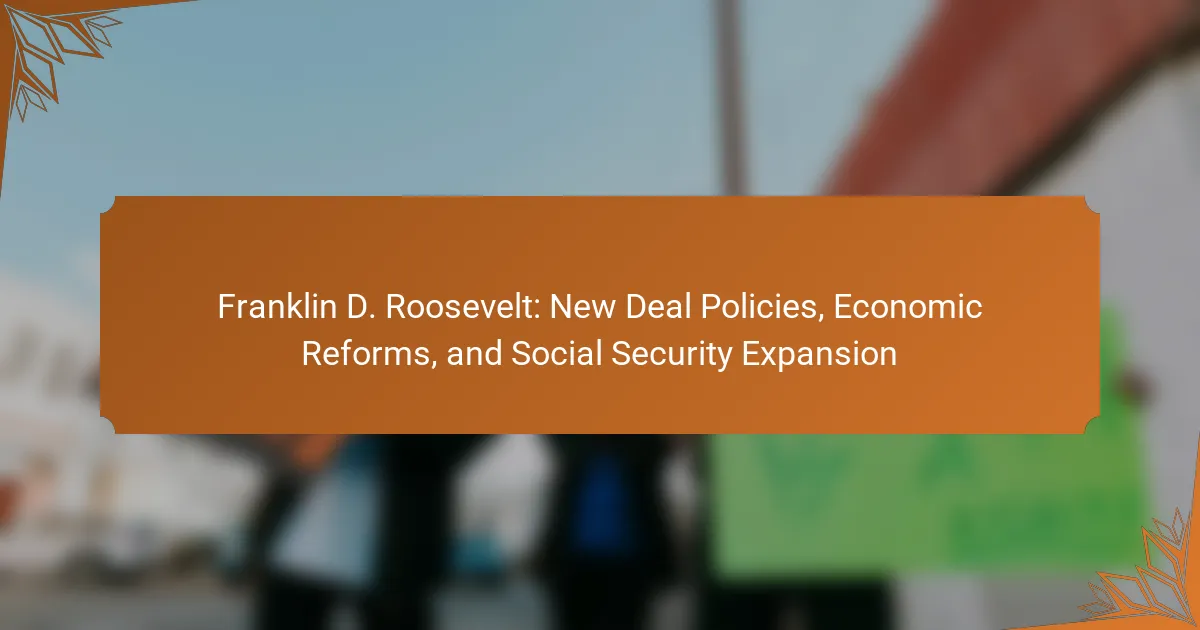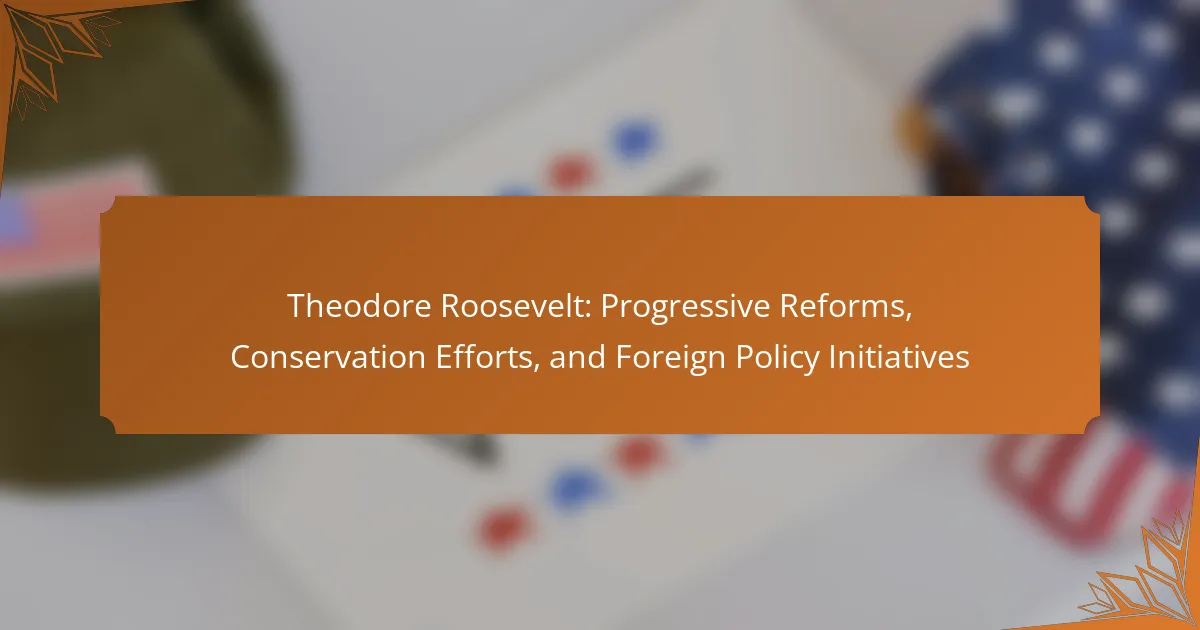Ronald Reagan, the 40th President of the United States, is recognized for his distinct communication style, which is marked by clarity, warmth, and optimism. His speeches often utilized simple language, personal anecdotes, and humor to engage audiences effectively. Reagan’s economic policies, collectively known as “Reaganomics,” focused on tax cuts, deregulation, and reducing government spending, leading to significant economic growth in the 1980s but also contributing to increased income inequality. Additionally, Reagan’s aggressive anti-communist stance and military strategies played a crucial role in shaping Cold War dynamics, including the initiation of the Strategic Defense Initiative and support for anti-communist movements globally, ultimately influencing the collapse of the Soviet Union.
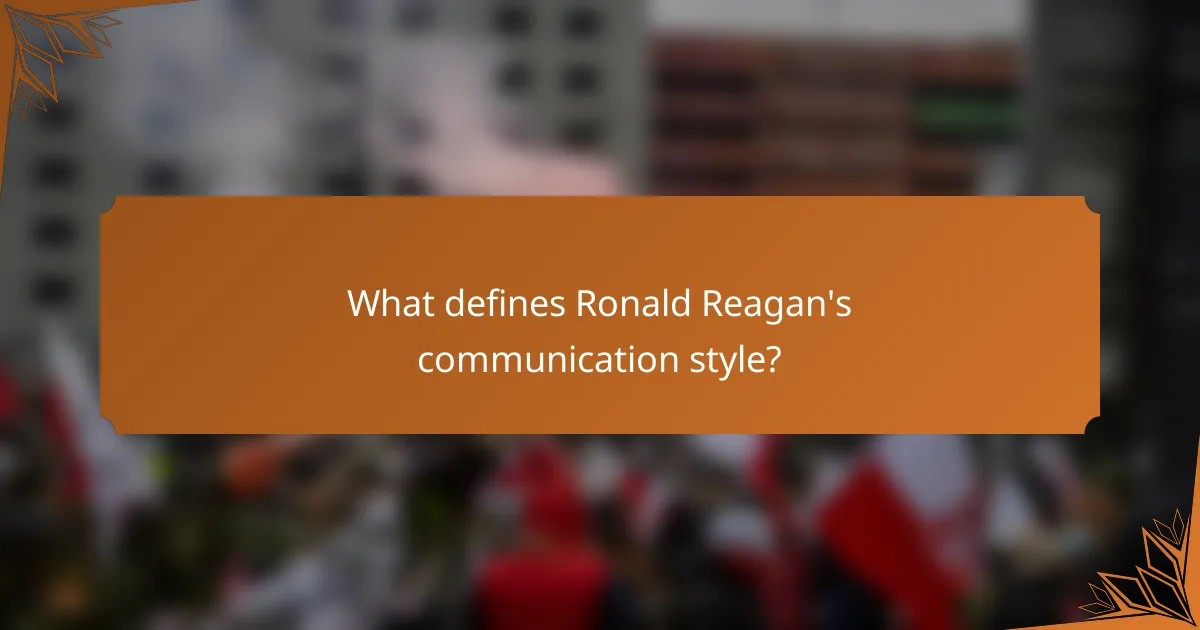
What defines Ronald Reagan’s communication style?
Ronald Reagan’s communication style is defined by its clarity, warmth, and optimism. He often used simple language to convey complex ideas. Reagan’s speeches featured anecdotes and personal stories to connect with audiences. He had a knack for using humor to disarm critics and engage listeners. His delivery was characterized by a calm and reassuring tone. Reagan also employed a conversational style that made him relatable. He was skilled at using pauses for emphasis, enhancing his message’s impact. His ability to articulate a vision helped rally support during challenging times, particularly during the Cold War.
How did Reagan’s background influence his communication approach?
Reagan’s background as an actor significantly shaped his communication approach. His experience in Hollywood honed his skills in public speaking and presentation. Reagan understood the importance of storytelling in engaging an audience. He often used anecdotes to connect with the public on a personal level. His Midwestern roots instilled a sense of relatability and authenticity. Reagan’s optimistic worldview influenced his positive messaging style. He emphasized hope and American values in his speeches. This background contributed to his effectiveness as a communicator during his presidency.
What were the key elements of Reagan’s public speaking techniques?
Reagan’s public speaking techniques included simplicity, storytelling, and strong emotional appeal. He often used clear and straightforward language that resonated with everyday Americans. His speeches frequently featured personal anecdotes, making complex issues relatable. Reagan’s use of humor helped to engage his audience and create a connection. He employed a conversational tone, which made him seem approachable and trustworthy. Additionally, he utilized effective body language and eye contact to enhance his message. His speeches were often well-structured, with a clear beginning, middle, and end, allowing audiences to follow his arguments easily. These elements contributed to his effectiveness as a communicator, particularly during pivotal moments in American history.
How did his use of humor impact his communication effectiveness?
Ronald Reagan’s use of humor significantly enhanced his communication effectiveness. Humor made his messages more relatable and engaging. It helped to diffuse tension in serious discussions. Reagan’s light-hearted remarks often disarmed critics and opponents. This approach fostered a sense of connection with the audience. For instance, during debates, his witty comebacks showcased his confidence. Studies show that humor can improve audience retention of information. Reagan’s ability to incorporate humor contributed to his popularity and legacy as a communicator.
What role did media play in shaping Reagan’s communication style?
Media significantly influenced Ronald Reagan’s communication style. Reagan effectively utilized television to connect with the public. His performances in televised debates, particularly against Jimmy Carter in 1980, showcased his charisma. This helped him establish a relatable image. Reagan’s use of soundbites made complex policies more digestible. His storytelling approach engaged audiences and humanized political issues. The media’s portrayal of him as a “Great Communicator” reinforced this image. Additionally, Reagan’s strategic use of press conferences allowed him to control narratives. Overall, media played a crucial role in shaping and amplifying his communication effectiveness.
How did Reagan utilize television to connect with the public?
Ronald Reagan effectively utilized television to connect with the public through his charismatic presence and strategic messaging. He became known as “The Great Communicator” for his ability to engage viewers. Reagan’s use of televised speeches, such as his 1984 re-election campaign, showcased his optimistic vision. He often employed storytelling techniques to make complex issues relatable. His appearances on popular shows, like “The Tonight Show,” helped humanize him to the audience. Reagan’s adeptness at using visuals and sound bites made his messages memorable. This approach significantly enhanced his public image and political influence.
What strategies did he employ to manage press relations?
Ronald Reagan employed several strategies to manage press relations effectively. He utilized a friendly and approachable demeanor to build rapport with journalists. This strategy helped create a positive image and fostered cooperation. Reagan also emphasized clear and concise messaging, which made his communication more effective. He often used humor to disarm critics and engage the media. Additionally, Reagan’s administration practiced proactive media outreach, ensuring that key messages reached the public. Regular press briefings were conducted to maintain transparency and keep journalists informed. These strategies contributed to a favorable relationship with the press, allowing Reagan to communicate his policies effectively.
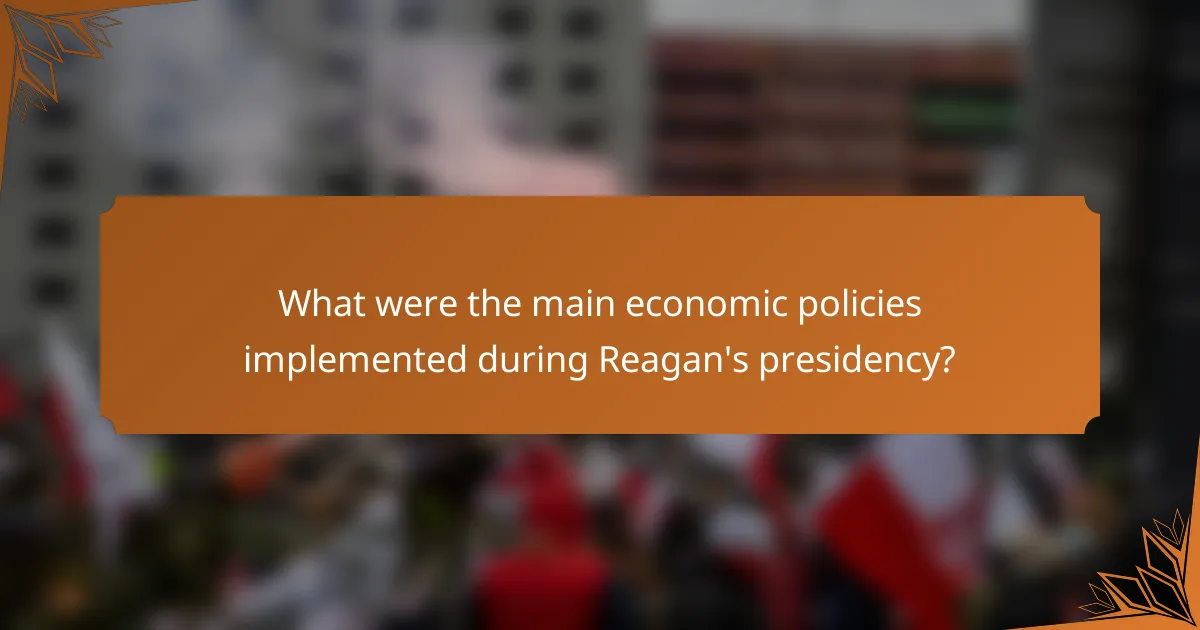
What were the main economic policies implemented during Reagan’s presidency?
The main economic policies implemented during Reagan’s presidency were known as “Reaganomics.” Reaganomics focused on tax cuts, deregulation, and reducing government spending. The Economic Recovery Tax Act of 1981 reduced income tax rates by 25% over three years. This aimed to stimulate economic growth by increasing disposable income. Deregulation targeted various industries, including transportation and energy, to promote competition. Reagan’s administration also emphasized reducing the size of government, which included cuts to social programs. These policies contributed to significant economic growth during the 1980s, with GDP increasing by 26% from 1983 to 1989. However, they also led to increased income inequality and a growing national deficit.
How did Reagan’s economic philosophy influence his policy decisions?
Reagan’s economic philosophy, known as supply-side economics, significantly influenced his policy decisions. This approach emphasized tax cuts, deregulation, and reducing government spending. Reagan believed that lowering taxes would stimulate investment and economic growth. His administration implemented substantial tax cuts through the Economic Recovery Tax Act of 1981. This act reduced the top income tax rate from 70% to 50%. Reagan also prioritized reducing inflation and unemployment through monetary policy. He appointed Paul Volcker to the Federal Reserve, supporting tight monetary policies to curb inflation. These decisions reflected his belief in the power of free markets to drive economic prosperity. Overall, Reagan’s economic philosophy shaped major policies that aimed to revitalize the American economy during his presidency.
What were the key components of Reaganomics?
The key components of Reaganomics included tax cuts, deregulation, and increased military spending. Tax cuts aimed to stimulate economic growth by boosting consumer spending. The Economic Recovery Tax Act of 1981 reduced income tax rates significantly. Deregulation focused on eliminating government restrictions on businesses. This approach encouraged investment and innovation. Increased military spending was intended to strengthen national defense. Reaganomics also emphasized reducing government size and influence in the economy. These policies aimed to combat inflation and stimulate job creation. Economic growth was a primary goal, with a focus on supply-side economics.
How did tax cuts impact economic growth during his administration?
Tax cuts during Ronald Reagan’s administration significantly stimulated economic growth. The Economic Recovery Tax Act of 1981 reduced individual income tax rates by 25% over three years. This policy aimed to increase disposable income and encourage consumer spending. Consequently, GDP growth averaged 4.5% annually from 1983 to 1989. Unemployment rates fell from 10.8% in 1982 to 5.4% by 1989. Additionally, tax cuts incentivized business investment, contributing to job creation. The expansion of the economy during this period is often attributed to these fiscal policies.
What were the short-term and long-term effects of Reagan’s economic policies?
Reagan’s economic policies led to both short-term and long-term effects. In the short term, these policies resulted in a significant reduction in inflation rates, which fell from 13.5% in 1980 to 4.1% in 1988. Economic growth accelerated, with GDP growth averaging 3.5% annually during his presidency. Unemployment initially increased, peaking at 10.8% in 1982, but then decreased to 5.4% by 1989.
In the long term, Reagan’s policies contributed to a substantial increase in national debt, which tripled from $998 billion in 1981 to $2.9 trillion by 1989. Income inequality widened, with the wealthiest 1% seeing their share of income rise from 8% in 1980 to 18% by 1990. Additionally, deregulation in various industries led to increased competition but also contributed to economic volatility in sectors like savings and loans.
How did these policies affect unemployment rates?
Ronald Reagan’s economic policies significantly affected unemployment rates. Initially, unemployment rose to 10.8% in 1982 due to recession and inflation. However, following tax cuts and deregulation, the economy began to recover. By 1984, unemployment fell to 7.5%. Over the next few years, it continued to decrease, reaching 5.4% by 1989. These policies stimulated job creation and economic growth, demonstrating a clear correlation between Reagan’s economic strategies and declining unemployment rates.
What was the impact on inflation during and after his presidency?
During Ronald Reagan’s presidency, inflation decreased significantly. When he took office in 1981, inflation was around 10.3%. By the end of his second term in 1989, it had dropped to approximately 4.7%. This reduction was largely attributed to his economic policies, including tax cuts and deregulation. The Federal Reserve’s tight monetary policy during this period also played a crucial role. After his presidency, inflation remained relatively low throughout the 1990s, averaging around 3%. Reagan’s approach to combating inflation laid the groundwork for stable prices in subsequent years.
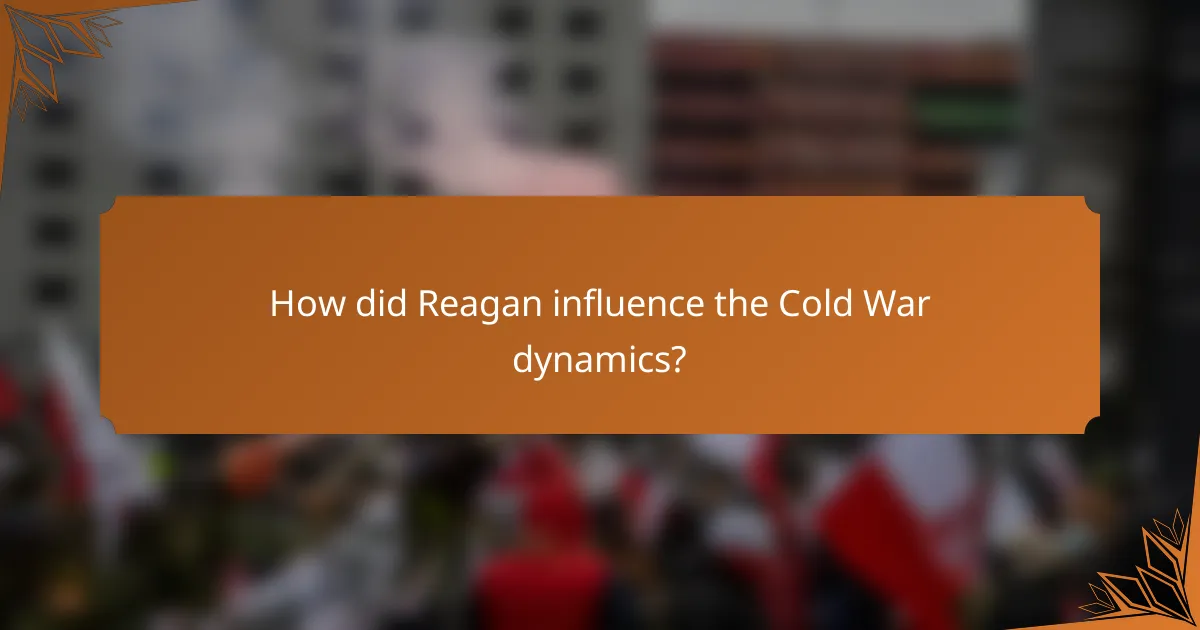
How did Reagan influence the Cold War dynamics?
Ronald Reagan influenced Cold War dynamics through his aggressive anti-communist stance and strategic military buildup. He initiated the Strategic Defense Initiative, aiming to protect the U.S. from nuclear missiles. Reagan’s rhetoric, including the famous “tear down this wall” speech, directly challenged Soviet power. His administration supported anti-communist movements globally, such as in Nicaragua and Afghanistan. This support strained Soviet resources and contributed to their eventual collapse. Economic pressure from Reagan’s policies also weakened the Soviet economy. By promoting a strong military presence, Reagan shifted the balance of power in favor of the U.S. His leadership played a pivotal role in the Cold War’s conclusion.
What strategies did Reagan employ in foreign policy regarding the Soviet Union?
Ronald Reagan employed a combination of military buildup, diplomatic engagement, and economic pressure in his foreign policy towards the Soviet Union. He initiated the Strategic Defense Initiative, which aimed to develop missile defense systems. This military strategy was intended to deter Soviet aggression. Reagan also engaged in arms reduction talks, leading to the Intermediate-Range Nuclear Forces Treaty in 1987. His administration utilized economic sanctions to weaken the Soviet economy. Additionally, Reagan’s rhetoric, including calling the Soviet Union an “evil empire,” aimed to rally public support against communism. These strategies collectively contributed to the eventual decline of Soviet influence.
How did his approach differ from previous administrations?
Ronald Reagan’s approach differed from previous administrations through his emphasis on direct communication and optimism. He utilized media effectively, often addressing the public via televised speeches. Reagan’s economic policies, known as “Reaganomics,” prioritized tax cuts and deregulation, contrasting with the Keynesian approaches of his predecessors. His foreign policy focused on a strong military stance and a willingness to engage with adversaries, notably the Soviet Union. This marked a shift from the more cautious diplomacy of prior administrations. Reagan’s ability to connect with the American public fostered a sense of national pride and unity, which was less emphasized by earlier leaders.
What role did military buildup play in his Cold War strategy?
Military buildup was a central element of Ronald Reagan’s Cold War strategy. He believed that a strong military would deter Soviet aggression. Reagan significantly increased defense spending during his presidency. This included investments in nuclear weapons and advanced military technology. The strategy aimed to project American strength globally. Reagan’s administration argued that military superiority would lead to negotiations from a position of power. The buildup also sought to weaken the Soviet economy by forcing them to compete militarily. Historical context shows that this approach contributed to the eventual dissolution of the Soviet Union.
What were the key events that marked Reagan’s Cold War influence?
Key events that marked Reagan’s Cold War influence include the Strategic Defense Initiative (SDI) announced in 1983. This program aimed to develop a missile defense system to protect the U.S. from nuclear attack. Reagan’s administration also emphasized military buildup, increasing defense spending significantly. In 1987, he delivered the famous “Tear down this wall!” speech, urging Soviet leader Mikhail Gorbachev to dismantle the Berlin Wall. The signing of the Intermediate-Range Nuclear Forces Treaty in 1987 was another pivotal moment, eliminating an entire class of nuclear weapons. Additionally, Reagan’s diplomatic engagement with Gorbachev led to a thaw in U.S.-Soviet relations. These events collectively contributed to the eventual end of the Cold War.
How did the Reykjavik Summit contribute to Cold War tensions?
The Reykjavik Summit escalated Cold War tensions by highlighting deep ideological divides. During the 1986 summit, U.S. President Ronald Reagan and Soviet leader Mikhail Gorbachev discussed nuclear disarmament. Their negotiations revealed significant disagreements on the role of nuclear weapons. Reagan’s insistence on the Strategic Defense Initiative was particularly contentious. This defense program aimed to protect against missile attacks but was viewed by the Soviets as a threat. The failure to reach an agreement intensified mutual suspicions. Consequently, the summit did not lead to a reduction in arms but rather solidified existing hostilities. The lack of consensus demonstrated the challenges of diplomacy during this critical period.
What was the significance of the Berlin Wall’s fall in relation to Reagan’s policies?
The fall of the Berlin Wall on November 9, 1989, symbolized the success of Ronald Reagan’s anti-communist policies. Reagan’s administration emphasized a strong stance against the Soviet Union. His famous speech at the Berlin Wall in 1987, urging Gorbachev to “tear down this wall,” highlighted his commitment to promoting freedom. The wall’s fall marked the decline of Soviet influence in Eastern Europe. This event validated Reagan’s approach of using both diplomacy and military strength. It demonstrated the effectiveness of his economic policies, which aimed to weaken the Soviet economy. The end of the wall contributed to the eventual dissolution of the Soviet Union in 1991. Thus, the fall of the Berlin Wall was a pivotal moment that reinforced the impact of Reagan’s Cold War strategies.
What lessons can be learned from Reagan’s leadership style and policies?
Reagan’s leadership style and policies offer several lessons. First, effective communication is crucial for leadership. Reagan was known for his ability to connect with the public. He used simple language and relatable anecdotes, making complex ideas accessible. Second, optimism can drive policy success. Reagan’s positive outlook helped to inspire confidence during economic challenges. His policies, such as tax cuts and deregulation, aimed to stimulate growth. Third, strong foreign policy can shape global dynamics. Reagan’s approach to the Cold War emphasized strength, which contributed to the eventual collapse of the Soviet Union. Lastly, coalition-building is essential. Reagan worked with both parties to achieve legislative goals, demonstrating the value of bipartisanship. These lessons highlight the importance of communication, optimism, foreign policy strength, and collaboration in effective leadership.
How can current leaders apply Reagan’s communication strategies today?
Current leaders can apply Reagan’s communication strategies by emphasizing clarity and optimism. Reagan often used simple language to convey complex ideas. This approach helps audiences easily understand messages. Leaders should also focus on storytelling to create emotional connections. Reagan’s anecdotes made his points relatable and memorable. Additionally, leaders can adopt Reagan’s use of humor to disarm critics and build rapport. His ability to connect with diverse audiences is a key lesson. Lastly, consistency in messaging reinforces credibility, a hallmark of Reagan’s communication style. This strategy fosters trust and loyalty among followers.
What economic principles from Reagan’s era remain relevant in today’s context?
Tax cuts and deregulation from Reagan’s era remain relevant today. These principles aimed to stimulate economic growth by increasing disposable income and reducing government intervention. The Economic Recovery Tax Act of 1981 significantly lowered tax rates. This approach is echoed in current discussions about tax reform to promote investment and job creation. Additionally, deregulation in industries like telecommunications has fostered competition and innovation. Modern economic policies continue to reflect the belief that lower taxes and less regulation can drive economic expansion. Historical data shows that the U.S. economy experienced growth post-Reagan’s tax cuts, reinforcing the effectiveness of these principles.
Ronald Reagan is the primary entity discussed in this article, focusing on his communication style, economic policies, and influence during the Cold War. The article outlines Reagan’s clear and optimistic communication methods, characterized by relatable anecdotes and humor, which helped him connect with the public. It details his economic philosophy, known as Reaganomics, which emphasized tax cuts and deregulation, resulting in significant economic growth but also increased income inequality. Additionally, the article explores Reagan’s strategic military buildup and diplomatic efforts that shaped Cold War dynamics, ultimately contributing to the decline of Soviet influence and the fall of the Berlin Wall.
